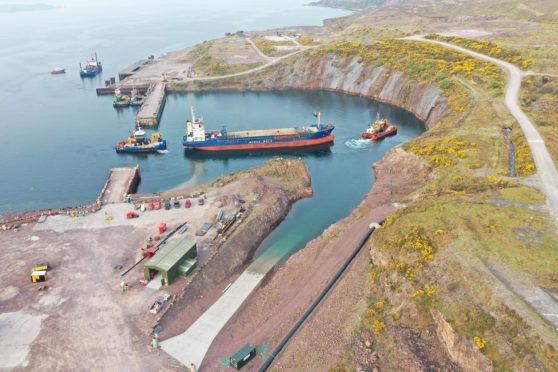A “21st century solution” to create the biggest marine development in the west Highlands, with the promise of 40 jobs and billions for the economy, has received the go ahead.
Kishorn Port will extend its dry-dock to accommodate marine structures and vessels of more than 820ft(250m) in length, as opposed to the current limitations of 520ft (160m).
The extension is a further and significant step in the regeneration of the port and dry dock which was originally established in the mid-1970’s to fabricate the Ninian Central oil and gas platform.
When completed, an extension of the dry dock into adjoining land will allow the port to receive vessels and structures up to 820ft/250 metres in length in comparison to the current 520ft/160 metres.
This will allow the port to accommodate a wider range of marine projects for decommissioning, maintenance and upgrade.
The decommissioning and offshore industry in the UK is estimated to be worth around £48bn over the next decade or so, with Kishorn expected to attract a 10% share.
The extension will also enhance the port’s offering to the offshore wind sector which, through the current ScotWind leasing round, will take on a significantly enhanced role in the generation of renewable energy in Scotland.
Some 1400 cubic feet of rock, from a 120ft high rock face will excavated from the dry dock extension to be used in the reclamation of an area of foreshore to provide further land within the port to support the various industry sectors which use the port now and into the future.
The project is expected to be complete within two years, with the work taking up to 12 months to complete.
Survey work will be carried out on the local access road to assess the extra pressure from traffic before mitigating developer contributions will be sought.
Local councillors on Highland Council’s north planning committee welcomed the promise of 40 more jobs in decommissioning, training for younger and older people and the multi-billion injection into the Scottish economy.
Councillor Biz Campbell said the development was more important than ever, post-Covid, and she welcomed the job opportunities and training.
Councillor Derek Macleod referenced the small handful of objectors to the application, saying: “If objectors had got their way in the 10970s there would never have been any development in Kishorn at all.
“I’m keen that the present generation should benefit from the additional work in the area.”
Committee chairwoman councillor Maxine Smith said she was confident that any objections can be mitigated by the amount of benefit to the economy.
For Kishorn Port Ltd (KPL) the approval is cause for celebration and confidence in the future.
KPL director Colin Ortlepp said: “We welcome the council’s approval of this proposal which follows a period of over ten years during which Kishorn Port has invested significantly to bring the dry dock and wider port area back to life.
“Last year saw three significant decommissioning and oil and gas projects use our facilities, and we believe the port will host many more projects in future as a direct result of Scotland’s energy transition.
“We’re extremely appreciative of the support we’ve had from the local community, the council, Highlands and Islands Enterprise and many others in our journey to bring work back to Kishorn.
“More activity at Kishorn gives us the ability to create further employment opportunities within Wester Ross.”
Alasdair Ferguson, a KPL director said the 40 new jobs will include project management, environmental, downsizing, catering, machine operation and manual roles, with the hope that 10-15% will be filled by local people.
“There’s a large variety of skills involved in decommissioning work, so there will be a large variety of good jobs.
“We’ll have home-grown talent for certain jobs and retraining locally for some staff, and then certain skills connected with reverse engineering of structures.
“This planning permission allows us to future proof the yard and be able to look at potential future contracts for decommissioning and offshore wind down the line, for manufacturing in the dock itself.
“We want to create an exemplary facility, with excellent track record, working with all the regulatory authorities and making sure that we do a good job in an enclosed environment which the dry dock delivers.
“It’s a 21st century solution for a real requirement for North Sea assets.”
KPL has started working with Skills Development Scotland, universities, schools, Highlands and Island Enterprise and chambers of commerce on the development of a young workforce equipped with the core skills required in manufacturing, decommissioning or offshore wind in future.
“We see real prospects over the next five to 10 years in decommissioning in the oil and gas sector, and the emerging market for offshore wind after that,” Mr Ferguson said.
